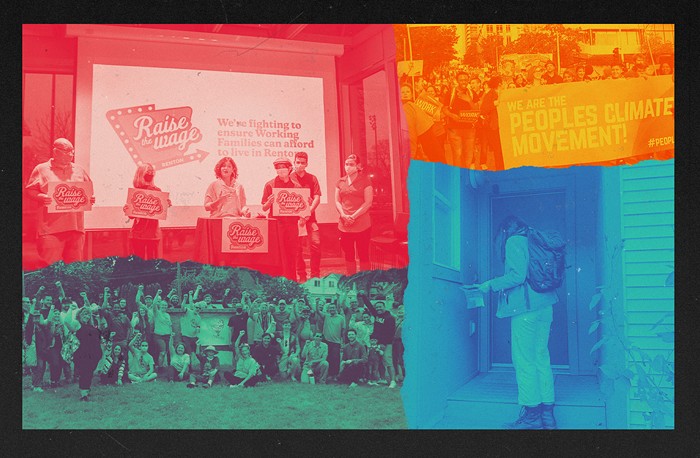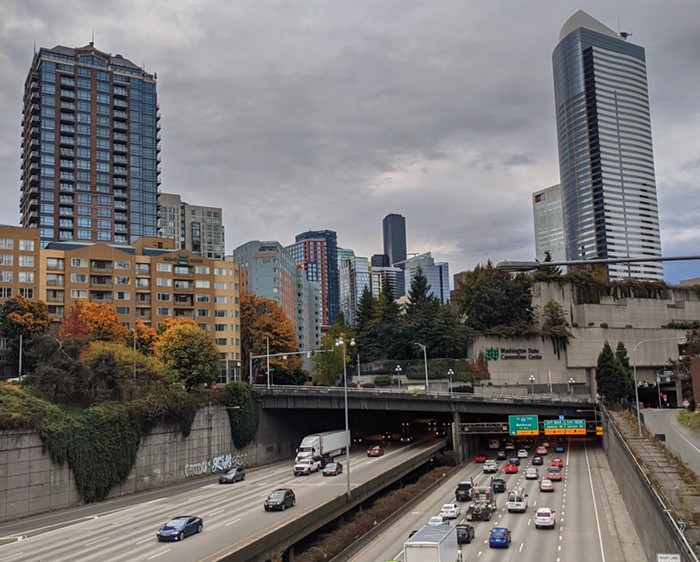
Mayor Jenny Durkan today announced a plan to sell off nearly three acres of city-owned land in South Lake Union to a private developer for $143.5 million. The deal includes a $5 million contribution from the developer to fight homelessness, 175 affordable housing units, and an expected $78.2 million infusion of cash to combat the city’s housing crisis.
Durkan has transmitted the plan to the city council, which still needs to approve the deal, and she hopes to close the sale sometime in 2020. Previewing the terms of the planned property sale to reporters last Friday, Durkan called it “one of the most consequential property deals the city has ever done, certainly in my lifetime.”
She continued: “This was a generational opportunity to take an underutilized, city-owned property and to make a real transformational investment, to create jobs, to create more affordable and mixed-income housing, and to build more safe transportation connections."
The deal involves selling the so-called “Mercer Mega Block,” a 2.86-acre tract of land along Mercer Street near Aurora Avenue, to Alexandria Real Estate Equities INC, a California-based property developer that specializes in developing properties for biotech and life science tenants. Alexandria plans to develop the property into three buildings: two new towers for biotechnology offices and a third tower that will include affordable housing.
The deal still needs the approval of the City Council and environmental and housing groups previously called on the mayor to build more than 175 units of affordable housing on the mega block prooerty. Durkan’s office claims that by selling the pricey land—which they claim they negotiated a high per-square-foot price for—and using that cash to develop housing elsewhere, the city will still experience a gain in affordable housing. We’ll see if the freshly-released plan will be able to satisfy critics and win over the city council.

Durkan’s administration first put out a request for proposal (RFP) for firms looking to buy and develop the site in July of 2018. Alexandria Real Estate Equities (ARE) was one of the strongest of the six qualified proposals the city received by October of 2018, but the firm’s price was substantially lower than the other proposals. So the city responded to them and told them had to increase their price, according to Steven Shain, a manager in the budget office.
“They had the best proposal but they didn’t have necessarily have the best price,” Shain told reporters last Friday. “We told them if you really want this site you need to come back and step up your proposal substantially.”
And that’s what ARE did, increasing the price of their offer by 40 percent, according to Shain. That put their offer at $138 million in cash for the property, as well as a one-time $5 million contribution into the city's budget to fight homelessness. Based on the developable square footage of the project, Shane said ARE is paying “a new benchmark rate” for South Lake Union properties.
“Typically in South Lake Union it’s been around $150 a developable square footage,” Shain said. “This is at about 175 [dollars a square foot] based on their early projection.”
ARE specializes in developing projects for tech and biotech companies and plans to develop two towers on the site that will be a “fully integrated mixed-use campus dedicated to accelerating the discovery and development of innovations that will positively impact human health,” according to a city presentation.
The base of these two towers will feature public spaces as well as a 30,000 square-foot community center that they will leave for 40 years, rent-free to the city’s Parks and Recreation Department.
A third tower for housing is planned on land between Dexter Avenue North and Aurora Avenue North. All three towers are still in the very early planning stage—their height and design still need to be worked out—but ARE has guaranteed that the third tower will have at least 175 units of affordable housing reserved for people making less than 60 percent of the area median income. The tower will also likely house additional affordable multifamily units as well as market-rate units. Noble said the tower could house as many as 190 more units, but exactly how won’t be determined until the building is closer to development.
“We don’t know precisely how many additional units, but having bought this land at a pretty penny they have every reason to build up essentially however much housing they can,” Noble said.
ARE will also be on the hook to pay for extending the Mercer Street protected bike lane as well as paying for improvements to 8th Avenue North.
The majority of the city's cash proceeds from the sale will go into combating Seattle's housing crisis, with $57.2 million going into purchasing new land around Seattle near transit projects with the intent to develop those projects into affordable housing. The bulk of that money will be spent on land acquisition for affordable housing, not directly building the actual units.
Another $15 million of the cash will be spent to try to increase the amount of middle or low-income earners that own homes in Seattle, by nearly doubling the city's portfolio of permanently affordable homeownership units, partnering with Sound Transit to create homeownership opportunities in the Rainier Valley, and explore partnership with private employers to boost affordable homeownership. Another $6 million from the sale will go into developing a new loan program for people looking to build backyard cottages on their properties in Seattle.
Shain said that in addition to the affordable housing built on the Meg Block site, and the cash used to build affordable housing elsewhere, the city will also reap the benefits of increased tax revenue from ARE building on the site.
“This is about a billion dollar overall project,” Shain said. “So while this transaction is one thing, there’s going to be other huge tax revenues that come out of the property, from construction dollars as well.”

Three Acres With Strings Attached
The city is the sole owner of the 2.86 acres that comprise the Mercer Mega Block, but that ownership has a few different strings attached. The city purchased the property with restricted funds and eventually took out debt against the land, all of which needs to be paid back. Those requirements constrained how the property could be sold and what can be done with that property.
“We didn’t own this property free and clear even though it was ours,” Ben Noble, the director of the city’s budget office, said last Friday.
The city purchased the land partially with funds collected through the commercial parking tax and gas tax, two funding sources that are legally required to be spent on transportation projects. That means the city is required to spend $25.9 million of the proceeds of the sale directly on transportation projects.
The city has also borrowed against the property to pay for four different projects: construction on the Mercer Mess ($12.2 million), maintenance on the South Lake Union Streetcar ($3.6 million), planning for the new Center City streetcar ($9 million), and funding homelessness services ($4.3 million). Those projects add up to $29.1 million in loans that will need to be repaid, or about 20 percent of the total cash proceeds from the sale to ARE.
The city is also bound by a 2018 ordinance that requires that 80 percent of the net proceeds from the sale of any surplus property be spent on building affordable housing. Only 55 percent of the proceeds of this sale, or $78.2 million, are going into funding housing, but the Durkan administration said they still met that 80 percent requirement because those loan repayments and restricted transportation uses took up 38 percent, or $55 million of the available funds.

Why Not More Public Housing?
Seattle is in the grip of an almost unprecedented housing crisis. One recent King County report estimated that the county needed to add a total of 244,000 affordable homes within 20 years to fight the crisis. So why didn’t the city just take these three acres near the center of Seattle and turn them into massive, soviet-style housing blocs with thousands of units?
That idea might sound attractive to people getting pushed out of the city, but Ben Noble, the director of the city’s budget office, said last Friday that selling off this pricey land and then investing it in cheaper land elsewhere will actually allow the city to build even more housing units.
“If we go into land acquisition with the resources we have, we can buy and put up more housing than we could have afforded [at this site], or at least as much as we could have here,” Noble said. “So every which way you look at it, we’re doing better for the public. It really makes more sense to liquidate this piece and take advantage of the resources.”
Durkan said the city doesn’t have enough funds to build housing on the site if they tried to go that route. And putting housing on the site would forgo the jobs and ongoing revenue that the private tech building will create.
“We would have to find revenues to build the housing, which as everyone knows we are short revenues in terms of building housing,” Durkan said. “We’ve leveraged this in a way that is better for the people of Seattle.”
Noble pointed out that if the city tried to redevelop the land itself, it would also be taking on the responsibility of doing environmental cleanup of the land and other area improvements.
“We would have to pay for cleanup, we don’t know how much [it would cost], again, their risk not ours,” Noble said. “You could easily be talking 50 million dollars of direct expense. So we’ve avoided that direct expense and we’re walking away with 78 million dollars as well as money to invest in transportation.”



















